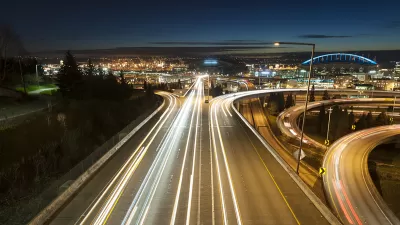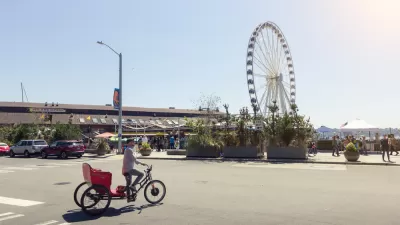With Mayor Jenny Durkan's announcement that Seattle will pursue cordon area congestion pricing coming five days after New York dropped its plan, a Washington State pro-business publication looks at the difficulties in getting the politics right.
Seattle Mayor Jenny Durkan announced on April 4 that her plans to reduce emissions from the transportation sector, responsible for two-thirds of the city's greenhouse gas emissions, would include cordon area congestion pricing, i.e., the tolling of downtown streets. If adopted, it would feature prominently in the Seattle Climate Action plan.
"While some transportation experts see congestion pricing as a viable solution– at least in theory – the success of any plan depends on a combination of implementation and political will," reports TJ Martinell on April 17 for Lens, "a preeminent pro-business, pro-growth online news publication in Washington state."
An [April 2008] Puget Sound Regional Council (PSRC) study [pdf] of a theoretical systemwide congestion pricing produced positive results and could work if implemented, but with the caveat if “done right.”
Angie Schmitt of Streetsblog USA reinforced the point in her blog of April 5 on the Seattle news:
But the politics of congestion pricing are tricky — the new tolls stir opposition, while the benefits aren’t immediately apparent until the policy is in effect — and only a handful of cities have enacted it.
As was shown by the outcome in the New York State legislature on March 30, and surprisingly even among Manhattan assembly members, without political will there is no congestion pricing. Martinell of Lens observes that will be a challenge for Mayor Durkan.
There’s also a lack of political will: a 2015 poll conducted by the Transportation Futures Task Force found over half of Puget Sound voters were either opposed or “strongly opposed” to regional tolling.
Regional or city tolling?
The PSRC study found that tolls on primary roads could easily cause traffic diversion to arterials.
But a Seattle-only toll could just push that traffic to nearby cities, says Washington Policy Center Transportation Director Mariya Frost. She writes that “people, businesses and cars may simply leave, and take emissions elsewhere. This could have a negative impact on Seattle’s economy, despite officials’ assumptions that thousands of drivers will submit and start to take transit.”
However, other experts in transportation, economics, and public policy argue just the opposite.
"Unlike other taxes that can be easily dismissed as imposing costs and killing jobs, congestion pricing improves market efficiencies because it forces people to think about their travel and leads to a more rational use of our public roads," stated John Rennie Short of the School of Public Policy, University of Maryland in February. "In my view, it is a powerful policy whose time has definitely come."
"Around the world, [traffic] is a drag on economic activity and the quality of life," wrote former New York Times economics writer David Leonhardt in January. "People waste hours in it, all the while sending pollution into the air."
A downtown cordon toll, if properly constructed, could prove no different than congestion pricing for downtown parking, making more spaces available for those willing to pay.
Seattle’s tolling interests
Seattle has been here before. The Seattle Variable Tolling Study [pdf] "responds to the [2006] Seattle Climate Action Plan’s direction to investigate variable tolling as a strategy to reduce greenhouse gas emissions," states the executive summary of the 117-page, May 2009 report prepared by Booz Allen Hamilton in conjunction with the City of Seattle Department of Transportation.
The agency should be able to use much of this work, though the technology has obviously advanced considerably. However, the politics have changed even more, and may just motivate the city to go where no other North American city has gone.
"In the time of Trump..."
In her April 4 announcement, the city's commitment to meeting the Paris climate agreement featured prominently. In addition, she told KUOW, Seattle's NPR affiliate:
"In the time of Trump, if local governments, particularly cities, don't lead, we as a country won't meet our climate goals," she said.
==============================
Advice from Stockholm
“Designing an efficient and effective congestion pricing scheme that actually delivers benefits is not easy,” states Stockholm transportation director Jonas Eliasson in an article last November accompanying a Streetfilms video on the Stockholm congestion charge.
Eliasson should know, as he "steered the implementation of congestion pricing in Stockholm in 2006," wrote David Meyer for Streetsblog NYC on Nov. 29.
Before implementation, public support for congestion pricing had fallen below 40 percent. After a six-month trial period in 2006, more than 52 percent of Stockholm residents voted to make it permanent. By 2011, public support for road pricing stood at nearly 70 percent, and above 50 percent even among people who pay the fees most often.
By reducing auto trips, 20 percent in Stockholm's case, congestion pricing not only improves economic activity but public health as well, as Fredrick Kunkle reported for The Washington Post on March 27, 2017.
Researchers at Johns Hopkins University and other institutions who studied Stockholm’s congestion-pricing scheme found that the policy cut air pollution in the city center and reduced childhood asthma cases by nearly 50 percent. The long-term health benefit of congestion-pricing also seemed to become more apparent the longer the policy was in effect.
"To Meet Emissions Goals, Seattle Wants to Charge Drivers," Scientific American, April 6.
FULL STORY: The politics of congestion tolling

Planetizen Federal Action Tracker
A weekly monitor of how Trump’s orders and actions are impacting planners and planning in America.

Congressman Proposes Bill to Rename DC Metro “Trump Train”
The Make Autorail Great Again Act would withhold federal funding to the system until the Washington Metropolitan Area Transit Authority (WMATA), rebrands as the Washington Metropolitan Authority for Greater Access (WMAGA).

DARTSpace Platform Streamlines Dallas TOD Application Process
The Dallas transit agency hopes a shorter permitting timeline will boost transit-oriented development around rail stations.

San Francisco's School District Spent $105M To Build Affordable Housing for Teachers — And That's Just the Beginning
SFUSD joins a growing list of school districts using their land holdings to address housing affordability challenges faced by their own employees.

Car-Centric LA Suburb Looks to a Train-Oriented Future
City leaders in Rancho Cucamonga, the future western terminus of the Brightline West rail line to Las Vegas, want to reimagine the city as a transit-oriented, pedestrian-friendly community.

New Alaska Bitcoin Mine Would Burn as Much Energy as the State’s Largest Coal Plant
Fueled by “stranded” natural gas, the startup hopes to become the largest in the US, and to make Alaska an industry center.
Urban Design for Planners 1: Software Tools
This six-course series explores essential urban design concepts using open source software and equips planners with the tools they need to participate fully in the urban design process.
Planning for Universal Design
Learn the tools for implementing Universal Design in planning regulations.
Municipality of Princeton
Roanoke Valley-Alleghany Regional Commission
City of Mt Shasta
City of Camden Redevelopment Agency
City of Astoria
Transportation Research & Education Center (TREC) at Portland State University
US High Speed Rail Association
City of Camden Redevelopment Agency
Municipality of Princeton (NJ)





























